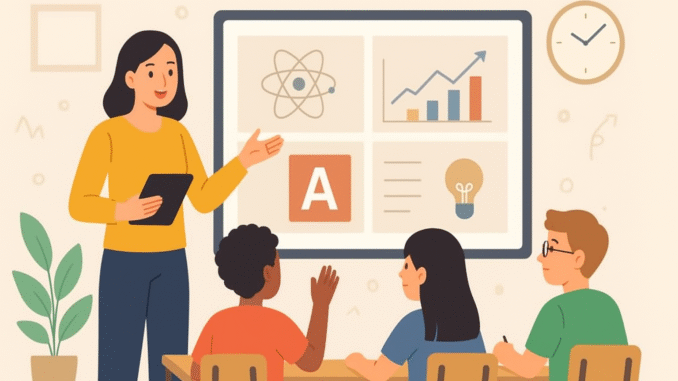
Top 10 Innovative Teaching Methods Transforming Modern Education in 2025
The world of education is changing faster than ever. As we move through 2025, traditional classrooms are evolving into interactive, technology-driven learning environments. Teachers are no longer just knowledge providers—they are facilitators, mentors, and innovators. With the integration of artificial intelligence, virtual reality, and personalized learning systems, modern education has become more engaging and effective than ever before.
In this article, we will explore the top 10 innovative teaching methods transforming modern education in 2025 and how these approaches are shaping the learners of tomorrow.
1. Blended Learning: The Perfect Mix of Online and Offline Education
Blended learning combines traditional classroom teaching with digital learning resources. In 2025, this approach has become a core part of most schools and universities. Students attend physical classes but also access lessons, quizzes, and discussions online at their own pace.
This hybrid model allows for flexibility and personalized instruction. Teachers can track each student’s progress using data analytics and tailor lessons accordingly. With tools like Google Classroom, Microsoft Teams, and AI-based learning platforms, blended learning ensures that students stay connected and motivated both inside and outside the classroom.
2. Project-Based Learning (PBL): Learning by Doing
Project-Based Learning emphasizes hands-on experiences where students tackle real-world problems. Instead of memorizing facts, learners work on meaningful projects that require creativity, collaboration, and critical thinking.
For instance, a science class might involve designing an eco-friendly energy solution, or a social studies project might focus on community development. PBL not only enhances knowledge retention but also builds essential life skills such as teamwork and problem-solving.
In 2025, educators are integrating AI tools and digital project management platforms to guide students through every phase of their projects, from research to presentation.
3. Gamification in Education: Making Learning Fun
Gamification transforms education into an exciting, game-like experience. By integrating game elements such as points, badges, leaderboards, and levels, students become more engaged and motivated to learn.
Platforms like Kahoot!, Quizizz, and Classcraft are popular examples. These tools turn lessons into interactive games, encouraging participation and healthy competition. In 2025, gamification has expanded beyond quizzes—teachers now use virtual reality games and AI simulations to teach complex topics in science, math, and history.
The result? Students who are not only learning more effectively but also enjoying the process.
4. Flipped Classroom: Reversing the Traditional Model
The flipped classroom approach turns traditional learning upside down. Instead of listening to lectures in class and doing homework afterward, students first learn new content online at home through videos, readings, and podcasts. Class time is then used for discussions, problem-solving, and collaborative activities.
This model gives students greater control over their learning pace and frees up classroom time for deeper understanding. In 2025, many educators use AI-driven video lessons and adaptive learning apps to personalize the flipped classroom experience.
It’s a shift that empowers students to take responsibility for their education while allowing teachers to focus on guidance and support.
5. Personalized Learning Through Artificial Intelligence
Artificial Intelligence (AI) has revolutionized how teachers design and deliver education. With AI-powered systems, learning is now tailored to each student’s strengths, weaknesses, and learning style.
For example, AI can analyze performance data and recommend specific exercises or resources to help a student improve. Platforms like DreamBox, Century Tech, and Squirrel AI use machine learning algorithms to adjust lesson difficulty in real time.
In 2025, this approach ensures that no two students follow the exact same learning path—making education more inclusive and effective than ever before.
6. Virtual and Augmented Reality (VR & AR) Learning
Virtual and Augmented Reality have brought learning to life in extraordinary ways. Through VR headsets or AR-enabled devices, students can explore ancient civilizations, travel inside the human body, or conduct science experiments in a safe virtual environment.
For example, history classes use VR to simulate historical events, while medical students practice surgeries using AR overlays. This immersive experience improves comprehension, retention, and engagement.
As VR/AR technology becomes more affordable and accessible in 2025, schools worldwide are incorporating these tools into everyday lessons to make education more experiential and memorable.
7. Collaborative Learning: Building Knowledge Together
Collaborative learning encourages students to work together to achieve shared goals. Instead of competing, learners exchange ideas, solve problems collectively, and support one another.
Online tools like Miro, Padlet, and Slack have made collaboration easier than ever, especially in hybrid or remote learning setups. In 2025, collaborative learning extends beyond classrooms—students from different countries can work on global projects, gaining cross-cultural awareness and teamwork skills.
This method fosters communication, empathy, and leadership—qualities essential in today’s interconnected world.
8. Experiential Learning: Learning Through Real-Life Experiences
Experiential learning connects academic knowledge with real-world applications. It emphasizes learning through experiences, reflections, and active participation rather than passive listening.
Examples include internships, field trips, simulations, and community service projects. In 2025, digital experiential learning has expanded through virtual internships and simulation-based training programs.
By bridging the gap between theory and practice, students gain confidence and are better prepared for professional life after graduation.
9. Mindfulness and Social-Emotional Learning (SEL)
In the modern era, education is not just about academic excellence—it’s about developing emotional intelligence, resilience, and mental well-being. Social-Emotional Learning (SEL) focuses on self-awareness, empathy, communication, and decision-making.
Many schools now incorporate mindfulness exercises, meditation, and emotional check-ins into the daily schedule. AI-driven apps also help monitor student stress levels and suggest personalized mental health activities.
In 2025, educators understand that emotional well-being is key to academic success, and SEL has become a fundamental part of holistic education.
10. Microlearning: Short, Focused Learning Modules
Microlearning involves delivering content in small, easily digestible segments. Instead of long lectures, lessons are broken down into quick videos, infographics, quizzes, or podcasts—each focusing on a single concept.
This approach suits the fast-paced, mobile-first world of 2025. Learners can study on the go, using smartphones or tablets. Teachers use microlearning to reinforce key topics, making revision more efficient and engaging.
Platforms like Duolingo and Coursera use microlearning techniques to boost retention and motivation—proving that sometimes, less is more.
The Impact of Innovation on Modern Education
The adoption of these innovative methods is reshaping how students learn and how teachers teach. Modern education in 2025 is more interactive, inclusive, and data-driven than ever before. Technology has made learning accessible to anyone, anywhere, at any time.
Moreover, the shift from rote memorization to skill-based learning prepares students for the real world. Creativity, collaboration, and critical thinking are now as important as academic grades.
Educators are no longer simply lecturers—they are mentors guiding students to become lifelong learners and problem-solvers. As we continue into the future, education will keep evolving to meet the needs of a rapidly changing world.
Conclusion
The teaching methods shaping modern education in 2025 are proof that learning is no longer confined to textbooks and classrooms. With the help of technology, creativity, and empathy, teachers are transforming the educational landscape into one that inspires curiosity and innovation.
From AI-driven personalized learning to virtual classrooms and social-emotional development, these approaches are creating smarter, more adaptable learners ready to thrive in the future.
Education is not just about acquiring knowledge—it’s about inspiring minds, nurturing growth, and shaping the leaders of tomorrow.

